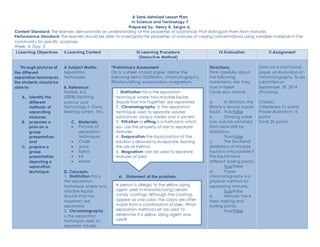
Deductive Method Lesson Plan
- 1. A Semi-detailed Lesson Plan in Science and Technology 7 Prepared by: Henry B. Sergio Jr. Content Standard: The learners demonstrate an understanding of the properties of substances that distinguish them from mixtures. Performance Standard: The learners should be able to investigate the properties of mixtures of varying concentrations using variable materials in t he community for specific purposes. Week: 4, Day: 3 I.Learning Objectives II.Learning Content III.Learning Procedure (Deductive Method) IV.Evaluation V.Assignment Through pictures of the different separation techniques, the students should be able to: A. identify the different methods of separating mixtures; B. proposes a plan on a group presentation; and C. prepare a group presentation depicting a separation technique. A.Subject Matter : Separation techniques B. Reference: Hadsal, A.S. (2008).Exploring science and technology II. Diwa learning system, Inc. C. Materials: Pictures of separation techniques Chalk Juice Salad Ink Water D. Concepts: 1. Distillation-this is the separation technique where two miscible liquids (liquids that mix together) are separated. 2. Chromatography - is the separation technique used to separate soluble *Preliminary Assessment On a ¼ sheet of pad paper, define the following terms: Distillation, chromatography, filtration/sifting, evaporation, magnetism. A. Statement of the problem. Directions: Think carefully about the following statements. Are they true or false? Circle your answer. a. In filtration, the filtrate is always a pure liquid. True/False b. Drinking water can only be obtained from seawater by distillation. True/False c. The fractional distillation of miscible liquids is only possible if the liquids have different boiling points. True/False d. Paper chromatography is a physical method for separating mixtures. True/False e. Mixtures have fixed melting and boiling points. True/False Draw on a short bond paper an illustration of chromatography. To be submitted on September 29, 2014. (Thursday) Criteria: Cleanliness-10 points Proper illustration 15 points Total: 25 points 1. Distillation-this is the separation technique where two miscible liquids (liquids that mix together) are separated. 2. Chromatography -is the separation technique used to separate soluble substances using a media and a solvent. 3. Filtration or sifting is a method in which you use the property of size to separate mixtures. 4. Evaporation-the liquid portion of the solution is allowed to evaporate, leaving the solute behind. 5. Magnetism can be used to separate mixtures of solid. A person is allergic to the yellow dying agent used in manufacturing certain candy coatings. Although the coatings appear as one color, the colors are often made from a combination of dyes. What separation method can be used to determine if a yellow dying agent was used?
- 2. substances using a media and a solvent. 3. Filtration or sifting is a method in which you use the property of size to separate mixtures. 4. Evaporation-the liquid portion of the solution is allowed to evaporate, leaving the solute behind. 5. Magnetism can be used to separate mixtures. D. Skill: Familiarizing oneself of the properties of mixtures that distinguish them from substances. F. Values Everything separates not for the bad for the benefit of each. J Candy coat B. Generalization The person could use paper chromatography to determine the other colors present. Paper Chromatography C. Inference 1. Define each separation technique using the vertical bullet list.
- 3. Distillation •this is the separation technique where two miscible liquids (liquids that mix together) are separated. Chromatography •-is the separation technique used to separate soluble substances using a media and a solvent. Filtration or sifting •is a method in which you use the property of size to separate mixtures. Evaporation •liquid portion of the solution is allowed toevaporate, leaving the solute behind. Magnetism •can be used to separate mixtures. 2. Show pictures for each technique. Distillation Chromatography
- 5. 3. Differentiate mixture from a substance Substance is an element or a compound (two or more elements that have reacted chemically in a fixed proportion by mass).We can separate the various constituents of a compound substance by a chemical process (reaction). Mixture is formed when two or more substances are mixed in any proportion. The constituents of a mixture can be separated by a physical process. 4. Using available resources inside the classroom, and the materials by the teacher, the group should be able to choose one separation technique and present it in class in a creative manner. The groups are given 10 minutes only to discuss and 5 minutes to present. 5. Group the class into 5 groups with 10 members. Example:
- 6. The students choose chromatography. Instead of color, they will represent it as the human race. And after series of investigations, the group separates the girls in the group from the boys. Criteria: Group discipline-10 points Accuracy of the presentation-15 points Total: 25 points D. Verification Base on the picture of distillation, answer the following questions. 1. The liquid solution is boiled in the boiler. The solvent evaporates. The solvent changes from a _____ to a gas (water vapor). 2. The vapor moves out of the boiler. It goes into the inner tube of the cooling section. 3. The cold water in the outer tube cools the vapor. This makes the vapor condense. The vapor changes from a ___ to a liquid. 4. The liquid drips into a container. It is pure. It has been distilled. It has no solute dissolved in it. 5. What happens to the solute? The solid solute stays behind in the boiler. It is now dried up. It is in solid form. Answers: 1. Liquid 2. Okay 3. Gas 4. Okay 5. Okay Final Assessment:
- 7. On a ¼ sheet of pad paper, the students are asked to write a brief explanation on as to how separation of techniques is important. Criteria: Neatness-5 points Accuracy of the answer-10 points Total: 15 points Separation techniques are important for us to know the components of materials. Being able to know its components is important for us to be aware of it.
